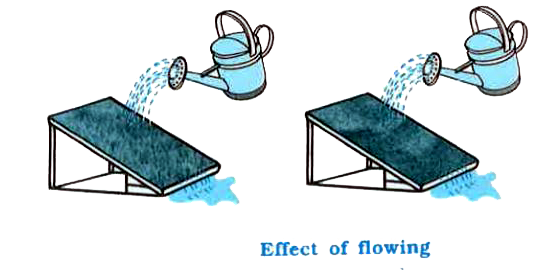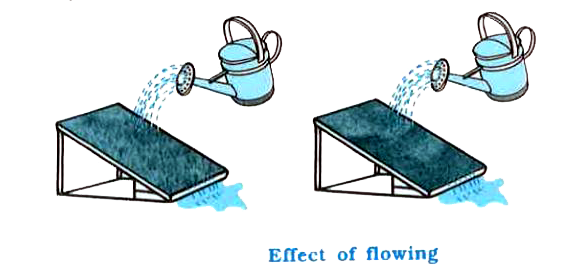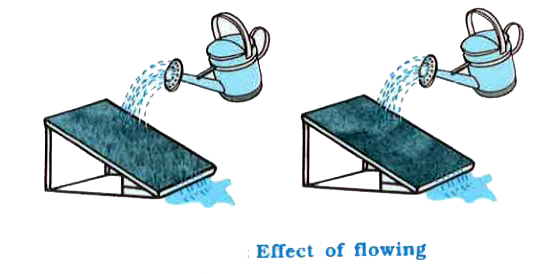Activity from KUMAR PRAKASHAN KENDRA BIOLOGY (GUJRATI ENGLISH) NATURAL RESOURCES for Class 9
| Class 9 | BIOLOGY |
| Chapter | NATURAL RESOURCES |
| KUMAR PRAKASHAN KENDRA BIOLOGY (GUJRATI ENGLISH) | Activity |
| Medium | English |
| Academic Year | 2023-2024 |
Question 1
Measure the temperature of the following :
Take (i) a beaker full of water, (ii) a beaker full of soil / sand and (iii) a closed bottle containing a thermometer. Keep them in bright sunlight for three hours. Now measure the temperature of all 3 vessels. Also, take the temperature reading in shade at the same time.
Now answer the following questions :
Is the temperature reading more in activity (i) or (ii)?View SolutionQuestion 2
Measure the temperature of the following :
Take (i) a beaker full of water, (ii) a beaker full of soil / sand and (iii) a closed bottle containing a thermometer. Keep them in bright sunlight for three hours. Now measure the temperature of all 3 vessels. Also, take the temperature reading in shade at the same time.
Now answer the following questions :
Based on the above finding, which would become hot faster - the land or the sea ?View SolutionQuestion 3
Measure the temperature of the following :
Take (i) a beaker full of water, (ii) a beaker full of soil / sand and (iii) a closed bottle containing a thermometer. Keep them in bright sunlight for three hours. Now measure the temperature of all 3 vessels. Also, take the temperature reading in shade at the same time.
Now answer the following questions :
Is the thermometer reading of the temperature of air (in shade) the same as the temperature of sand or water?View SolutionQuestion 4
Measure the temperature of the following :
Take (i) a beaker full of water, (ii) a beaker full of soil / sand and (iii) a closed bottle containing a thermometer. Keep them in bright sunlight for three hours. Now measure the temperature of all 3 vessels. Also, take the temperature reading in shade at the same time.
Now answer the following questions :
What do you think is the reason for this? And why does the temperature have to be measured in the shade?View SolutionQuestion 5
Measure the temperature of the following :
Take (i) a beaker full of water, (ii) a beaker full of soil / sand and (iii) a closed bottle containing a thermometer. Keep them in bright sunlight for three hours. Now measure the temperature of all 3 vessels. Also, take the temperature reading in shade at the same time.
Now answer the following questions :
Is the temperature of air in the closed glass vessel/bottle the same as the temperature taken in open air?View SolutionQuestion 6
Measure the temperature of the following :
Take (i) a beaker full of water, (ii) a beaker full of soil / sand and (iii) a closed bottle containing a thermometer. Keep them in bright sunlight for three hours. Now measure the temperature of all 3 vessels. Also, take the temperature reading in shade at the same time.
Now answer the following questions :
What do you think is the reason for this?View SolutionQuestion 7
Measure the temperature of the following :
Take (i) a beaker full of water, (ii) a beaker full of soil / sand and (iii) a closed bottle containing a thermometer. Keep them in bright sunlight for three hours. Now measure the temperature of all 3 vessels. Also, take the temperature reading in shade at the same time.
Now answer the following questions :
Do we ever come across this phenomenon in daily life?View SolutionQuestion 15
Take an empty bottle of the sort in which bottled water is sold. Pour about 5-10 mL of water into it and close the bottle tightly. Shake it well or leave it out in the sun for ten minutes. This causes the air in the bottle to be saturated with water vapour.
Now, take a lighted incense stick. Open the cap of the bottle and allow some of the smoke from the incense sticks to enter the bottle. Quickly close the bottle once more. Make sure that the cap is fitting tightly. Press the bottle hard between your hands and crush it as much as possible. Wait for a few seconds and release the bottle. Again press the bottle as hard as you can.
Now answer the following questions :
When did you observe that the air inside seemed to become 'foggy'?View SolutionQuestion 16
Take an empty bottle of the sort in which bottled water is sold. Pour about 5-10 mL of water into it and close the bottle tightly. Shake it well or leave it out in the sun for ten minutes. This causes the air in the bottle to be saturated with water vapour.
Now, take a lighted incense stick. Open the cap of the bottle and allow some of the smoke from the incense sticks to enter the bottle. Quickly close the bottle once more. Make sure that the cap is fitting tightly. Press the bottle hard between your hands and crush it as much as possible. Wait for a few seconds and release the bottle. Again press the bottle as hard as you can.
Now answer the following questions :
When does this fog disappear?View SolutionQuestion 17
Take an empty bottle of the sort in which bottled water is sold. Pour about 5-10 mL of water into it and close the bottle tightly. Shake it well or leave it out in the sun for ten minutes. This causes the air in the bottle to be saturated with water vapour.
Now, take a lighted incense stick. Open the cap of the bottle and allow some of the smoke from the incense sticks to enter the bottle. Quickly close the bottle once more. Make sure that the cap is fitting tightly. Press the bottle hard between your hands and crush it as much as possible. Wait for a few seconds and release the bottle. Again press the bottle as hard as you can.
Now answer the following questions :
When is the pressure inside the bottle higher ?View SolutionQuestion 18
Take an empty bottle of the sort in which bottled water is sold. Pour about 5-10 mL of water into it and close the bottle tightly. Shake it well or leave it out in the sun for ten minutes. This causes the air in the bottle to be saturated with water vapour.
Now, take a lighted incense stick. Open the cap of the bottle and allow some of the smoke from the incense sticks to enter the bottle. Quickly close the bottle once more. Make sure that the cap is fitting tightly. Press the bottle hard between your hands and crush it as much as possible. Wait for a few seconds and release the bottle. Again press the bottle as hard as you can.
Now answer the following questions :
Is the 'fog' observed when the pressure in the bottle is high or when it is low?View SolutionQuestion 19
Take an empty bottle of the sort in which bottled water is sold. Pour about 5-10 mL of water into it and close the bottle tightly. Shake it well or leave it out in the sun for ten minutes. This causes the air in the bottle to be saturated with water vapour.
Now, take a lighted incense stick. Open the cap of the bottle and allow some of the smoke from the incense sticks to enter the bottle. Quickly close the bottle once more. Make sure that the cap is fitting tightly. Press the bottle hard between your hands and crush it as much as possible. Wait for a few seconds and release the bottle. Again press the bottle as hard as you can.
Now answer the following questions :
What is the need for smoke particles inside the bottle for this experiment ?View SolutionQuestion 20
Take an empty bottle of the sort in which bottled water is sold. Pour about 5-10 mL of water into it and close the bottle tightly. Shake it well or leave it out in the sun for ten minutes. This causes the air in the bottle to be saturated with water vapour.
Now, take a lighted incense stick. Open the cap of the bottle and allow some of the smoke from the incense sticks to enter the bottle. Quickly close the bottle once more. Make sure that the cap is fitting tightly. Press the bottle hard between your hands and crush it as much as possible. Wait for a few seconds and release the bottle. Again press the bottle as hard as you can.
Now answer the following questions :
What might happen you do the experiment without the smoke from the incense stick? Now try it and check if the prediction was correct. What might be happening in the above experiment in the absence of smoke particles? View SolutionQuestion 21
Collect information from newspapers or weather reports on television about rainfall patterns across the country. Also find out how to construct a rain gauge and make one. What precautions are necessary in order to get reliable data from this rain gauge ?
Now answer the following questions :
In which month did your city/town / village get the maximum rainfall ? View SolutionQuestion 22
Collect information from newspapers or weather reports on television about rainfall patterns across the country. Also find out how to construct a rain gauge and make one. What precautions are necessary in order to get reliable data from this rain gauge ?
Now answer the following questions :
In which month did your state / union territory get the maximum rainfall ?View SolutionQuestion 23
Collect information from newspapers or weather reports on television about rainfall patterns across the country. Also find out how to construct a rain gauge and make one. What precautions are necessary in order to get reliable data from this rain gauge ?
Now answer the following questions :
If not, in which season do you get more of thunder and lightning with the rain ?View SolutionQuestion 25
Organisms called lichens are found to be very sensitive to the levels of contaminants like sulphur dioxide in the air. Lichens can be commonly found growing on the barks of trees as a thin greenish-white crust. See if you can find lichen growing on the trees in your locality.View SolutionQuestion 29
Select a small area (say, 1 m2) near a water body, it may be a river, stream, lake or pond. Count the number of different animals and plants in this area. Also, check the number of individuals of each type or species. Compare this with the number of individuals (both animals and plants) found in an area of the same size in a dry, rocky region. Is the variety of plant and animal life the same in both these areas?View SolutionQuestion 30
Select and mark out a small area (about 1 m2) in some unused land in or near your school. As in the above activity, count the number of different animals and plants in this area and the number of individuals of each species. Remember to do this in the same place twice in a year, once during summer or the dry season and once after it has rained.
Now answer the following questions:
Were the numbers similar both times ?View SolutionQuestion 31
Select and mark out a small area (about 1 m2) in some unused land in or near your school. As in the above activity, count the number of different animals and plants in this area and the number of individuals of each species. Remember to do this in the same place twice in a year, once during summer or the dry season and once after it has rained.
Now answer the following questions:
In which season did you find more variety of plants and animals?View SolutionQuestion 32
Select and mark out a small area (about 1 m2) in some unused land in or near your school. As in the above activity, count the number of different animals and plants in this area and the number of individuals of each species. Remember to do this in the same place twice in a year, once during summer or the dry season and once after it has rained.
Now answer the following questions:
In which season did you find more number of individuals of each variety?View SolutionQuestion 33
Take some soil and put it into a beaker containing water. The water should be at least five times the amount of soil taken. Stir the soil and water vigorously and allow the soil to settle down. Observe after some time.
Now answer the following questions :
Is the soil at the bottom of the beaker homogenous or have layers formed ?View SolutionQuestion 34
Take some soil and put it into a beaker containing water. The water should be at least five times the amount of soil taken. Stir the soil and water vigorously and allow the soil to settle down. Observe after some time.
Now answer the following questions :
If layers have formed, how is one layer different from another?View SolutionQuestion 35
Take some soil and put it into a beaker containing water. The water should be at least five times the amount of soil taken. Stir the soil and water vigorously and allow the soil to settle down. Observe after some time.
Now answer the following questions :
Is there anything floating on the surface of the water ?View SolutionQuestion 36
Take some soil and put it into a beaker containing water. The water should be at least five times the amount of soil taken. Stir the soil and water vigorously and allow the soil to settle down. Observe after some time.
Now answer the following questions :
Do you think some substances would have dissolved in the water? How would you check ?View SolutionQuestion 37
Take two identical trays and fill them with soil. Plant mustard or green gram or paddy in one of the trays and water both the trays regularly for a few days, till the first tray is covered by plant growth. Now, tilt both the trays and fix them in that position. Make sure that both the trays are tilted at the same angle. Pour equal amount of water gently on both trays such that the water flows out of the trays.

Study the amount of soil that is carried out of the trays. Is the amount the same in both the trays?View SolutionQuestion 38
Take two identical trays and fill them with soil. Plant mustard or green gram or paddy in one of the trays and water both the trays regularly for a few days, till the first tray is covered by plant growth. Now, tilt both the trays and fix them in that position. Make sure that both the trays are tilted at the same angle. Pour equal amount of water gently on both trays such that the water flows out of the trays.

Now pour equal amounts of water on both the trays from a height. Pour three or four the amount that you poured earlier. Study the amount of soil that is carried out of the trays now. Is the amount the same in both the trays ? View SolutionQuestion 39
Take two identical trays and fill them with soil. Plant mustard or green gram or paddy in one of the trays and water both the trays regularly for a few days, till the first tray is covered by plant growth. Now, tilt both the trays and fix them in that position. Make sure that both the trays are tilted at the same angle. Pour equal amount of water gently on both trays such that the water flows out of the trays.

Is the amount of soil that is carried out more or less or equal to the amount washed out earlier ? View Solution
All Exercises from KUMAR PRAKASHAN KENDRA BIOLOGY (GUJRATI ENGLISH) Class 9 BIOLOGY NATURAL RESOURCES
- ACTIVITY
- INTEXT QUESTIONS AND ANSWERS
- QUESTIONS AND ANSWERS
- QUESTIONS AND ANSWERS (ANSWER THE FOLLOWING QUESTIONS IN BRIEF)
- QUESTIONS AND ANSWERS (ANSWER THE FOLLOWING QUESTIONS IN DETAIL)
- QUESTIONS AND ANSWERS (ANSWER THE FOLLOWING QUESTIONS IN ONE WORD OR ONE SENTENCE)
- QUESTIONS AND ANSWERS (ANSWER THE FOLLOWING QUESTIONS IN SHORT)
- QUESTIONS AND ANSWERS (ANSWER THE FOLLOWING QUESTIONS IN VERY SHORT)
- QUESTIONS AND ANSWERS (CHOOSE THE CORRECT OPTION FROM THOSE GIVEN BELOW EACH QUESTION)
- QUESTIONS AND ANSWERS (FILL IN THE BLANKS BY SELECTING THE CORRECT ALTERNATIVE FROM THOSE GIVEN IN THE BRACKET)
- QUESTIONS AND ANSWERS (FILL IN THE BLANKS)
- QUESTIONS AND ANSWERS (GIVE DEFINITION OF THE FOLLOWING)
- QUESTIONS AND ANSWERS (GIVE SCIENTIFIC REASONS FOR THE FOLLOWING STATEMENTS)
- QUESTIONS AND ANSWERS (NAME OF THE FOLLOWING)
- QUESTIONS AND ANSWERS (STATE WHETHER THE FOLLOWING STATEMENTS ARE TRUE OR FALSE)
- VALUE BASED QUESTIONS WITH ANSWERS
